Alleviation: An International Journal of Nutrition, Gender & Social Development, ISSN 2348-9340 Volume 1, Number 1 (2014), pp. 1 - 8
© Arya PG College, Panipat & Business Press India Publication, Delhi
www.aryapgcollege.com
An Intervention on Imparting Awareness on Hygiene & Sanitation to School Children
Rameshwari Pandya, Anjali Pahad
Professors, Department of Extension & Communication,
Faculty of Family & Community Sciences, The M.S.University of Baroda (Gujarat), India
Email: anjalipahad@yahoo.com
Introduction
Children are the best change agents and can therefore play an effective role in creating a healthy and clean environment in the schools as well as in their homes. Schools after the family, are the best demonstration centres to bring about positive behavioral changes on a sustained basis. Schools play an important role for the cognitive development of children. Schools stimulate teaching environment and positive social and behavioral changes. The schools are very important place to address the health issues and challenges of children. For this, the school infrastructures as well as the teachers have to play significant role in bringing improved health and quality learning amongst children. The children have rights to basic facilities such as school toilets, safe drinking water, clean surroundings and information on hygiene and other life skills. If all these conditions are fulfilled, then they will attend school, enjoy learning and spread their learning to their families. Thus the provision of basic hygiene and sanitation conditions in the schools, provide the child survival, protection and development. Teacher-child-parents community is a proven route to spread the message of good and accepted hygiene and sanitary practices and hence school sanitation and hygiene education programme is widely popular in many states of our country. This programme addresses the various issues of school sanitation which not only deals with the issues of water supply and sanitation but also promote hygiene and sanitation education.
National Urban Sanitation Policy
Ministry of Urban Development, India has developed and published the National Urban Sanitation Policy in 2008. The vision of this policy is that all Indian cities and towns should become totally sanitized, healthy and liveable and ensure and sustain good public health and environmental outcomes for all their citizens with a special focus on hygiene and affordable sanitation facilities for the urban poor and women. In order to achieve this, following key policy issues must be addressed:
Poor awareness: Sanitation has been accorded low priority and there is poor awareness about its inherent linkages with public health.
Social and occupational aspects of sanitation: Despite the appropriate legal framework, progress towards the elimination of manual scavenging has shown limited success, little or no attention has been paid towards the occupational hazard faced by sanitation workers daily.
Fragmented institutional roles and responsibilities: There are considerable gaps and overlaps in institutional roles and responsibilities at the national, state and city levels.
Lack of an integrated city-wide approach: Sanitation investments are currently planned in a piece-meal manner and do not take into account the full cycle of safe confinement, treatment and safe disposal.
Limited technology choices: Technologies have been focused on limited options that have been cost-effective, and sustainability of investments has been in question.
Reaching the un-served and poor: Urban poor communities as well as other residents of informal settlements have been constrained by lack of tenure, space or economic constraints, in obtaining affordable access to safe sanitation. In this context, the issues of whether services to the poor should be individualized and whether community service should be provided in non-notified slums should be addressed. However provision of individual toilets should be prioritized. In relation to Pay and Use toilets, the issues of subsidies inadvertently reaching the non-poor should be addressed by identifying different categories of urban poor.
Lack of demand responsiveness: Sanitation has been provided by public agencies in a supply-driven manner, with little regard for demands and preferences of households as customers of sanitation services.
The overall goal of this policy is to transform Urban India into community-driven, totally sanitized, healthy and liveable cities, towns and villages. Thus, the above mentioned efforts by the government of India and non-governmental organizations reveal that initiatives have been taken at national and state levels with reference to urban and rural sanitation. Community cleanliness has been focused upon. With this understanding from these references, the present project was conceived to impart awareness regarding sanitation and hygiene amongst selected students of Maharani Laxmibai Primary School of Vadodara city.
Folk Media for Development of Communication
Communication is an essential input in development process of the society. No communication fully exists in cultural vacuum. Modern mass media is flourishing now-a-days, but these are not performing roles, which are expected from them due to several reasons, like lack of electricity, high cost, highly technical, and improper transport etc. Traditional folk media have a remarkable impact on the rural society because of their acceptable idioms, functional significance and entertainment components. Several authors have stated that traditional media are very effective in rural communication process. For a developing country like ours, folk media can reach the masses where other audio-visual media cannot e.g. to areas that have no electricity, where equipment cannot be brought inexpensively and where most of the population is illiterate. Unfortunately traditional media are used less frequently in extension teaching methods and national development process. Many development planners in the third world have appreciated the value of using traditional or folk media as an alternative communication strategy in development programmes. The new paradigm of development communication in many Third world societies now is that which seeks to emphasize the quality of life including the integration of traditional and modern systems of communications, labour intensive and appropriate technology, self- reliance, user-oriented strategies and popular participation in development planning and implementation. Thus it is well proven that folk media if properly utilized for dissemination of developmental messages to various sections of the society, especially children can prove very effective. Keeping above mentioned potentials of folk media in mind, it was decided to use selected folk media for imparting awareness on hygiene and sanitation amongst school children.
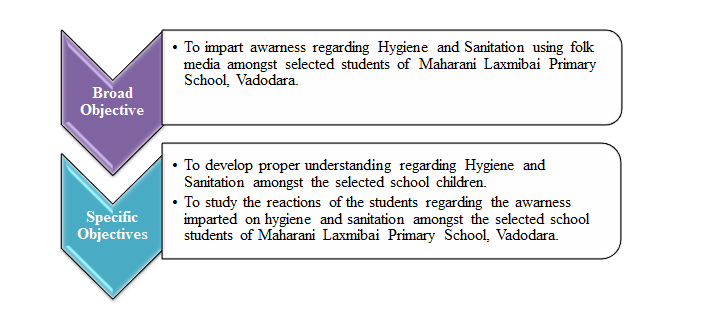
Justification of the Project
Sanitation and hygiene are the basic pre-requisites for the development of any community. They ensure healthy life for all, which in turn becomes social and economic concern for increasing production and promoting good life. It has been highlighted from many national and state level projects related to sanitation and hygiene, that to ensure positive behavior change in said aspects, it is not only essential to provide proper infrastructure but also ensure that the constant efforts should be made in this direction. As it is said that, in childhood we can shape child how we want. Further the concepts taught at this stage become a habit in adulthood. Thus, keeping in mind these points it was decided to conduct the project entitled. “Imparting Awareness regarding Hygiene and Sanitation using folk media amongst selected students” in Maharani Laxmibai Primary School. The initial visits to the School by the project worker concluded that the school lacked the general cleanliness and hygienic surroundings. The basic practices, like usage of dustbins and cleanliness of toilets were missing. The students of this school lacked awareness regarding their own personal hygiene also. This project was conducted in school, so that the students can adopt the sanitary practices in their homes and in community. The project was planned keeping in mind the city as well as state’s important need to create awareness on sanitation and hygiene so that the people remain healthy and clean.
Methodology
The methodology had been divided into four stages. These are as follows:
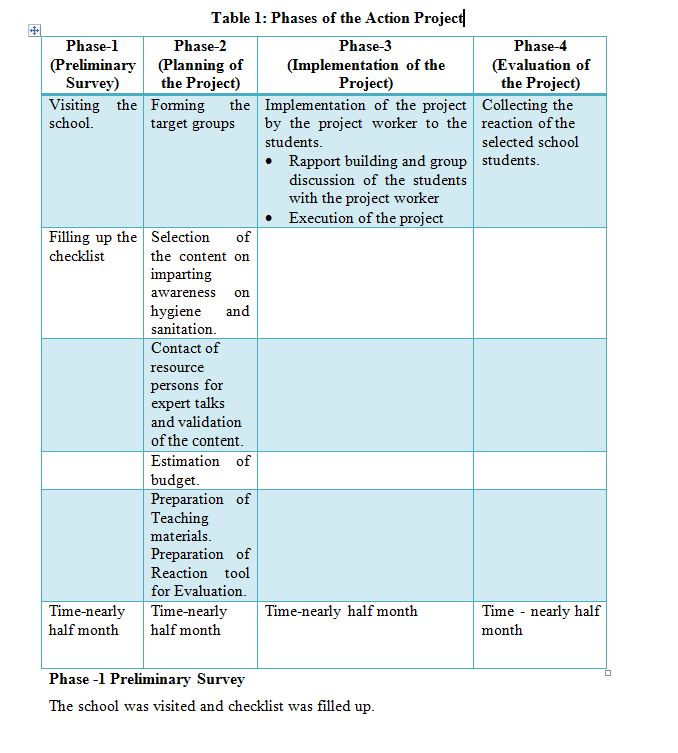
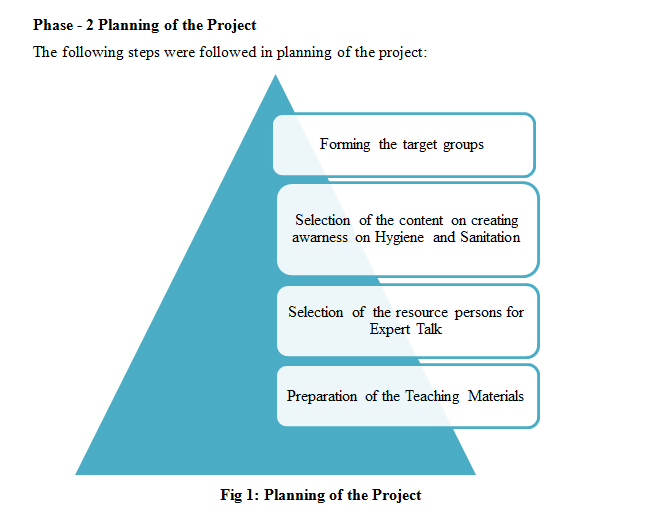
Phase -3 Implementation of the Project
The project worker visited the school and took permission. After that project worker met the students and communicated with the students. Project worker gave detailed information about the programme on imparting awareness regarding Hygiene and Sanitation, tried to build up rapport with the selected students.
Along with the formal meeting, project worker tried to know the awareness level about the Hygiene and Sanitation practices amongst the students. In that selected students expressed desire to learn the preparation of puppets also.
Phase - 4 Evaluation of the Programme
In the last phase, project worker evaluated the awareness generation programme. The reactions of the target group for the whole awareness generation programme are important for the project worker. Reaction scale was prepared by the project worker for the purpose to know the understanding of the target group. Once the reaction scale was prepared and validated by the experts, the project worker collected the reactions from the students.
Results
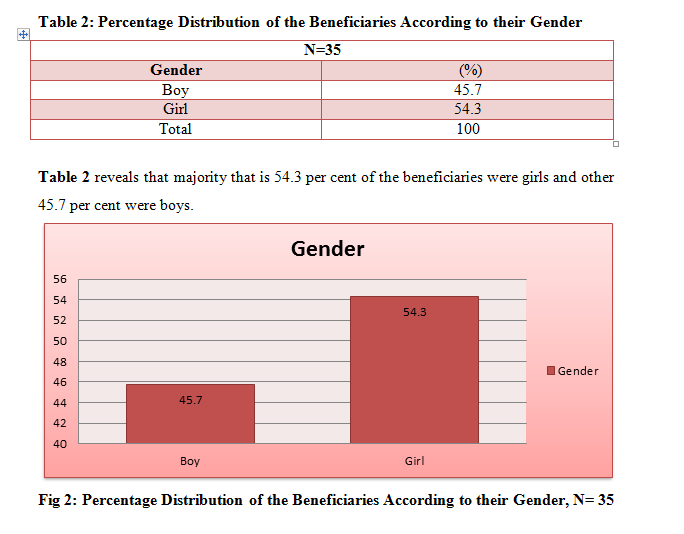
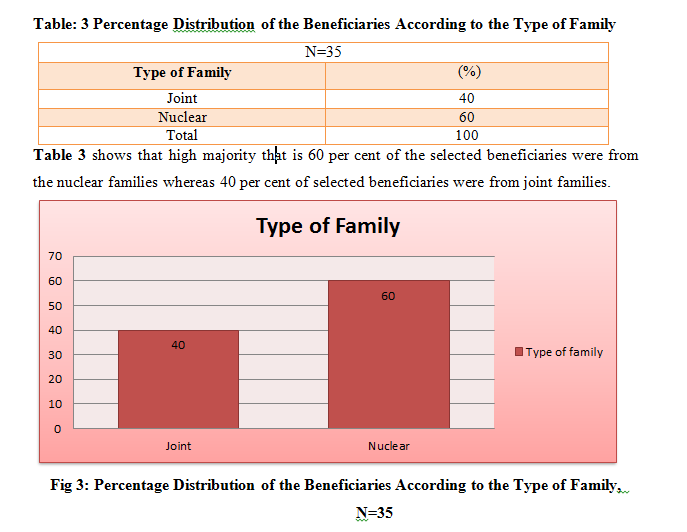
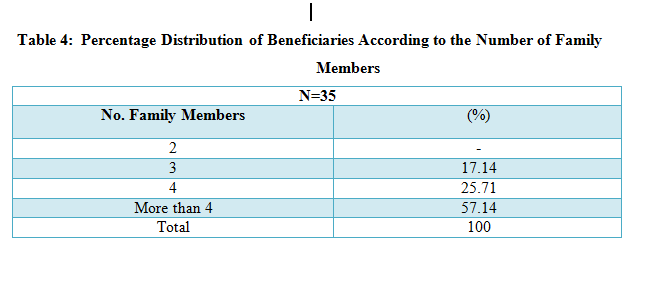
Table 4 shows that 57.14 per cent of beneficiaries had more than 4 members in their families, 25.71 per cent of the beneficiaries had 4 members in their families and very few that is 17.14 per cent of the beneficiaries had 3 members in their families.
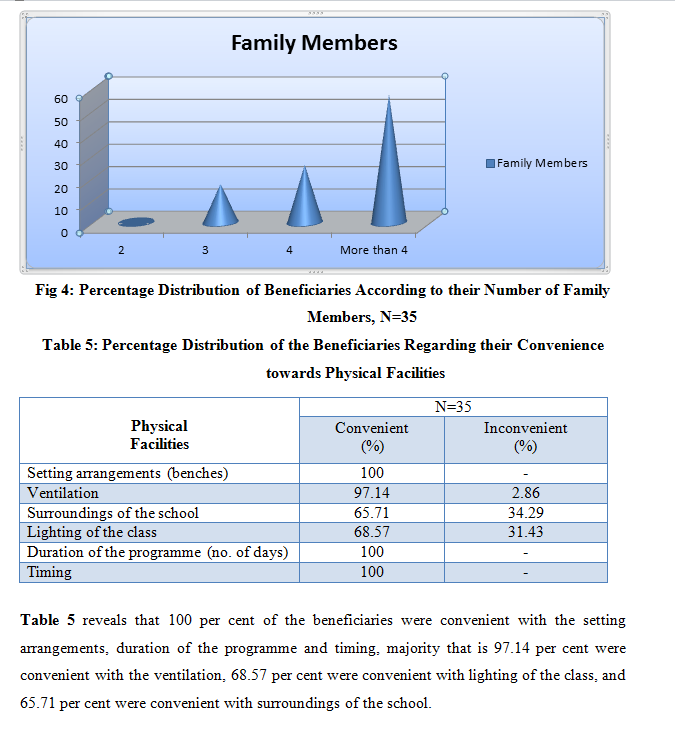
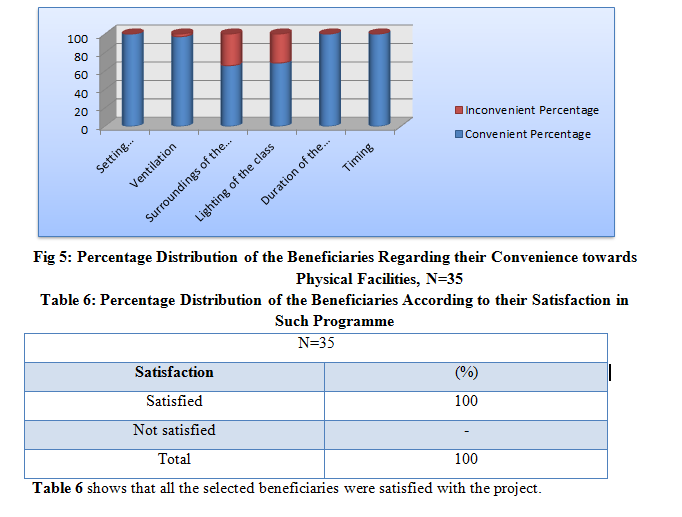
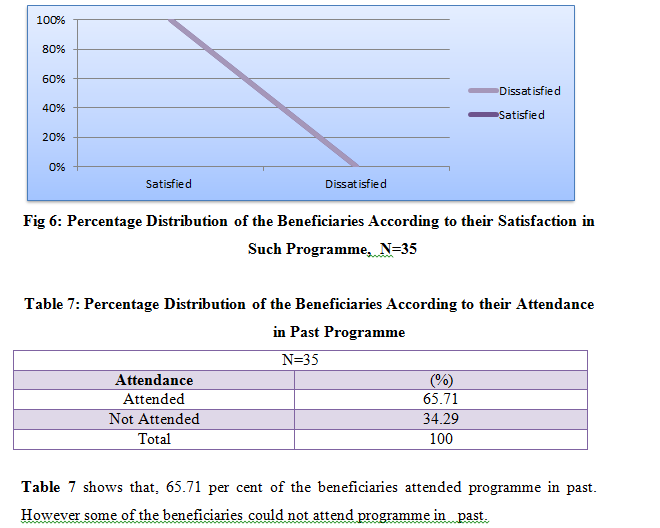
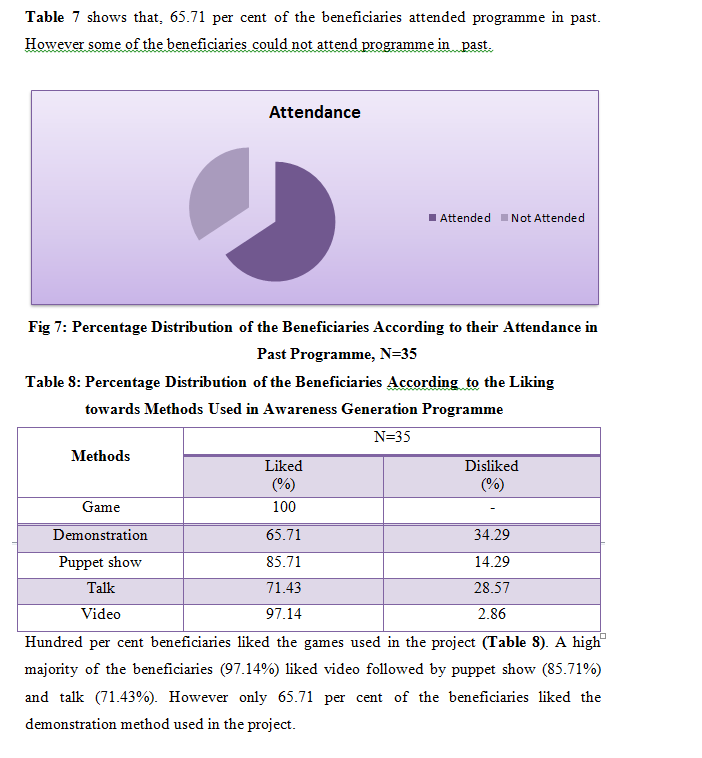
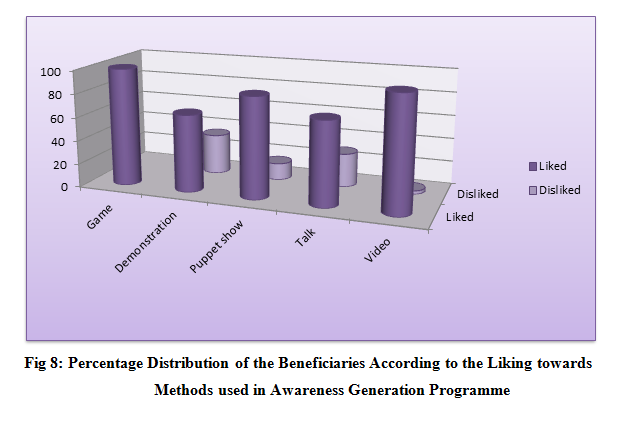
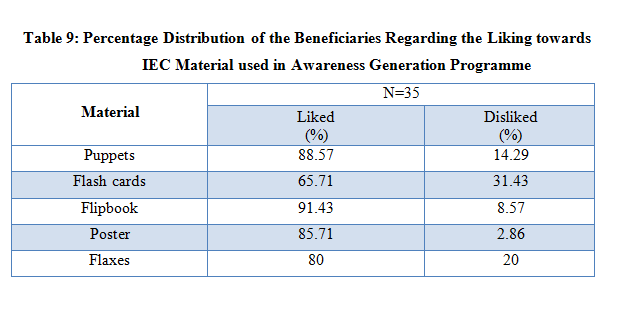
Table 9 reveals that 91.43 per cent of the beneficiaries liked flip book, 88.57 per cent of the beneficiaries liked puppets, 85.71 per cent of the beneficiaries liked posters, 80 per cent of the beneficiaries liked flexes and only 65.71 per cent of the beneficiaries liked flash cards.
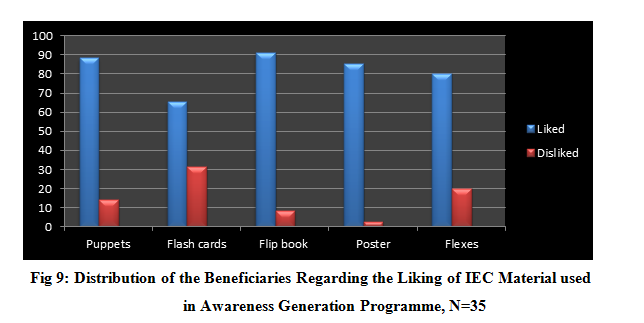
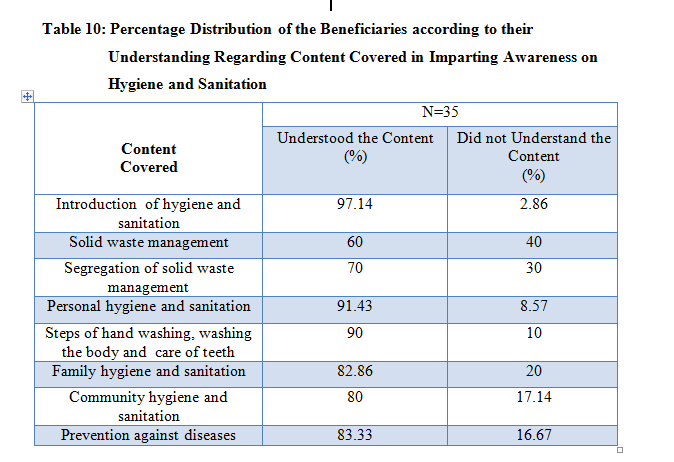
Table 10 shows 97.14 per cent of the beneficiaries understood the concept of hygiene and sanitation, 91.43 per cent of the beneficiaries understood personal hygiene and sanitation, 90 per cent of the beneficiaries understood the steps of hand washing, washing the body and care of teeth, 83.33 per cent understood prevention against diseases , 82.86 per cent understood family hygiene and sanitation, 80 per cent understood community hygiene and sanitation, 70 per cent beneficiaries understood segregation of solid waste management and only 60 per cent of the beneficiaries understood solid waste management.
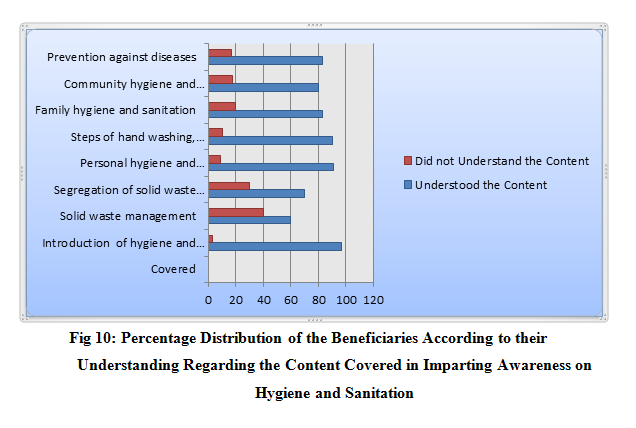
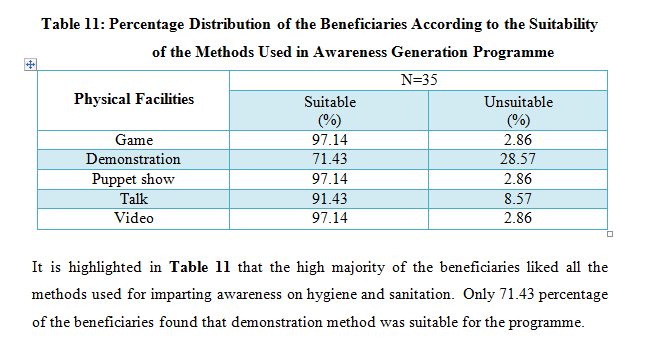
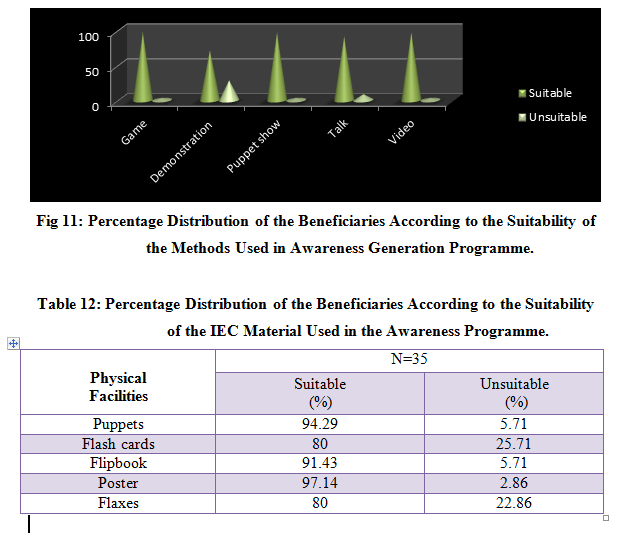
Table 12 shows that high majority of the beneficiaries liked all the information, education and communication (IEC) material used for imparting awareness on hygiene and sanitation i.e. Poster, Puppets, Flip book. Eighty per cent of the beneficiaries each found that the flash cards and flaxes were suitable for the programme.
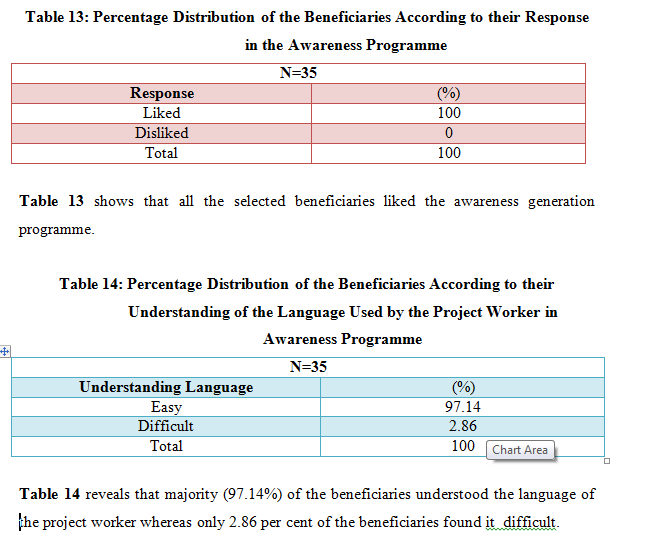
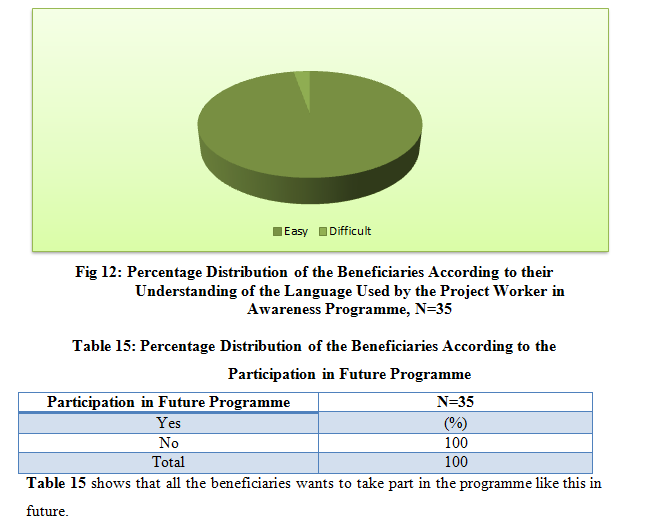
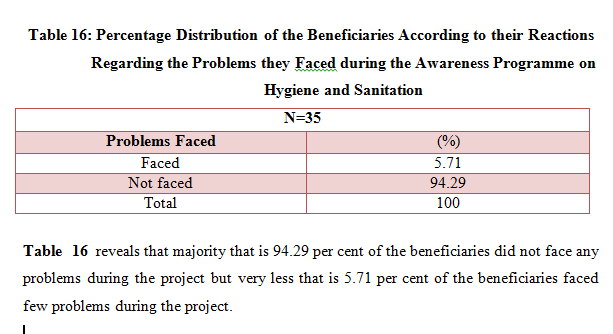
Outcomes of the Project
Students became aware and sanitized towards the hygiene and sanitation and their importance in personal, family and community level. The students falling sick due to unhygienic condition were low as per the project worker’s observation. Some of the beneficiaries had not attended such awareness programme in the past so they were interested to learn about the hygiene and sanitation. Majority of the students were aware about the personal, family, and community hygiene and sanitation. Thus, overall it was fruitful exercise of imparting awareness regarding hygiene and sanitation amongst the selected students of Maharani Laxmibai Primary School. They were motivated to learn and adopt hygiene and sanitation practices. This reflects that project was well accepted by the students and they were satisfied with the project
Conclusions
Access to improved hygiene and sanitation facilities does not, on its own, necessarily lead to improved health. There is now very clear evidence showing the importance of hygienic behaviour. This type of awareness programme may help students to improve their living and promote to adopt healthy practices in their day to day life. The purpose of this project was to initiate and strengthen the awareness level regarding hygiene and sanitation and also initiate to adopt hygiene and sanitation practices in the life of the students. To conclude, it reflects that sanitation and hygiene is a burning problem in today’s life. Many government and non- government organizations make efforts to solve the problems of sanitation in schools as well as in villages also. Through this project it has been found that they were motivated to adopt the practices in their day to day lifestyle.
Webliography
http://agropedia.iitk.ac.in/openaccess/sites/default/files/MDC%207.pdf
http://www.ahmedabadmirror.com/artical/51/201001182010011802414275165da3ffo/Kya-clean-hai-hum.html
http://www.cbse.nic.in/cenbosec/jul-sep-2009/page-56-69.pdf
http://dettol.co.in/topic_germs_3.html
http://indiasanitationportal.org/category/category/policies-and-programmes/national-urban-sanitation-policynusp
http://www.preservearticles.com/2012011821125/short-essay-on-the-impact-of-folk-media.html
http://www.unicief.org/india/reallivs_5789.htm
http://www.unicief.org/wash/index_hygiene.html
http://www.un.org/children/conflict/machel/english/85-the-essential-role-of-water-sanitation-and-hygiene.html

